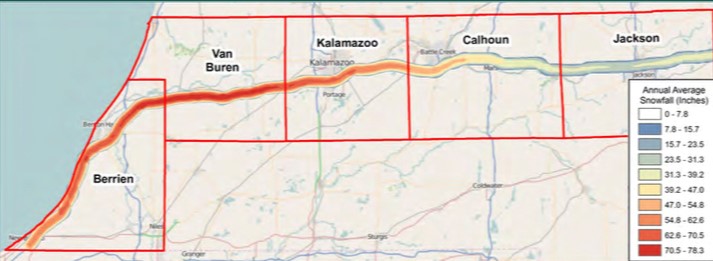The science of I-94's hazards
We all know that winter weather impacts the roads, but did you know the roads can impact winter weather? An evaluation of the I-94 corridor in Michigan sheds light into the potential dangers of the interstate.
In early 2015, the Michigan Department of Transportation conducted a study in response to a serious 193-vehicle accident in Kalamazoo County on 1-94. There was an interesting meteorological finding that explained the distribution of snow across the interstate.
On a small, localized scale, as systems move from west to east, snow is transported through a hypothetical “tunnel,” which means that snow that is close to the travels along the road as seen in the map below where the average snow totals on I-94 are not only high close to the lakeshore, but the high snow totals “travel” along I-94 for a while and taper off.
Nick Schirripa of MDOT’s southwest region compares this phenomenon to a favorite wintertime activity: ice skating.
“If you are gliding on ice skates along perfectly smooth ice and your ice skate catches a rut,” says Schirripa.
“With a little bit of effort, you can move your blade in and out of that rut but if there’s no other effort, it’ll catch that rut and kind of hold it and follow it. And that’s kind of like what I-94 does for weather.”
The weather is not the only cause of traffic woes, the geography can make weather look deceptive.
In the studied portion of the interstate, there’s a spot in Van Buren County near Pawpaw that has a climate in itself.
On 1-94 near Pawpaw - in between two hills, you’ll find a valley that has enough of an elevation change in that it can hold cold air and allow warm air to travel over it. Snow and ice sit longer in that valley.
Schirripa says this is one reason why you should always be aware of possible ice, snow and wind, and stay on high alert even if conditions don’t seem too bad.
"If you’re cruising along I-94, it’ll seem clear, everything’s fine, the sun’s out, it’s 39/40 degrees and you get over that hill and all of a sudden you drop down and it’s closer to freezing. There’s snow or ice on the road because it’s been colder, and because it holds that colder air its harder to clear that snow and ice and you have a crash. On the report, there are maps; that’s one of those hotspots for winter crashes on that map.”
Ice, snow, and wind can pack a powerful punch. As stated above, the roads can influence weather and elevation changes can influence road conditions, but what has MDOT combatted these issues?
I asked Nick Schirripa about what MDOT is doing to alleviate the dangers and damage done by these often unavoidable issues. Since the 2015 study, the agency has installed cable medians to lessen the impact of crashes. It has equipped snow plows with weather measurement tools to easily adapt to changing weather conditions. Road surfaces – like those with sharp turns – have changed to increase friction between the tire and the otherwise slippery surface.
But despite these changes, Schirripa says the biggest change starts with the drivers.
“When you’re on the road and you make a poor decision, you are gambling with other people’s lives,” says Schirripa. “We all think of ourselves as independent and I can do what I want. If I want to speed, I’m gonna speed. Well, you’re gambling with everybody’s lives around you because you’re not the only one on the road.”





